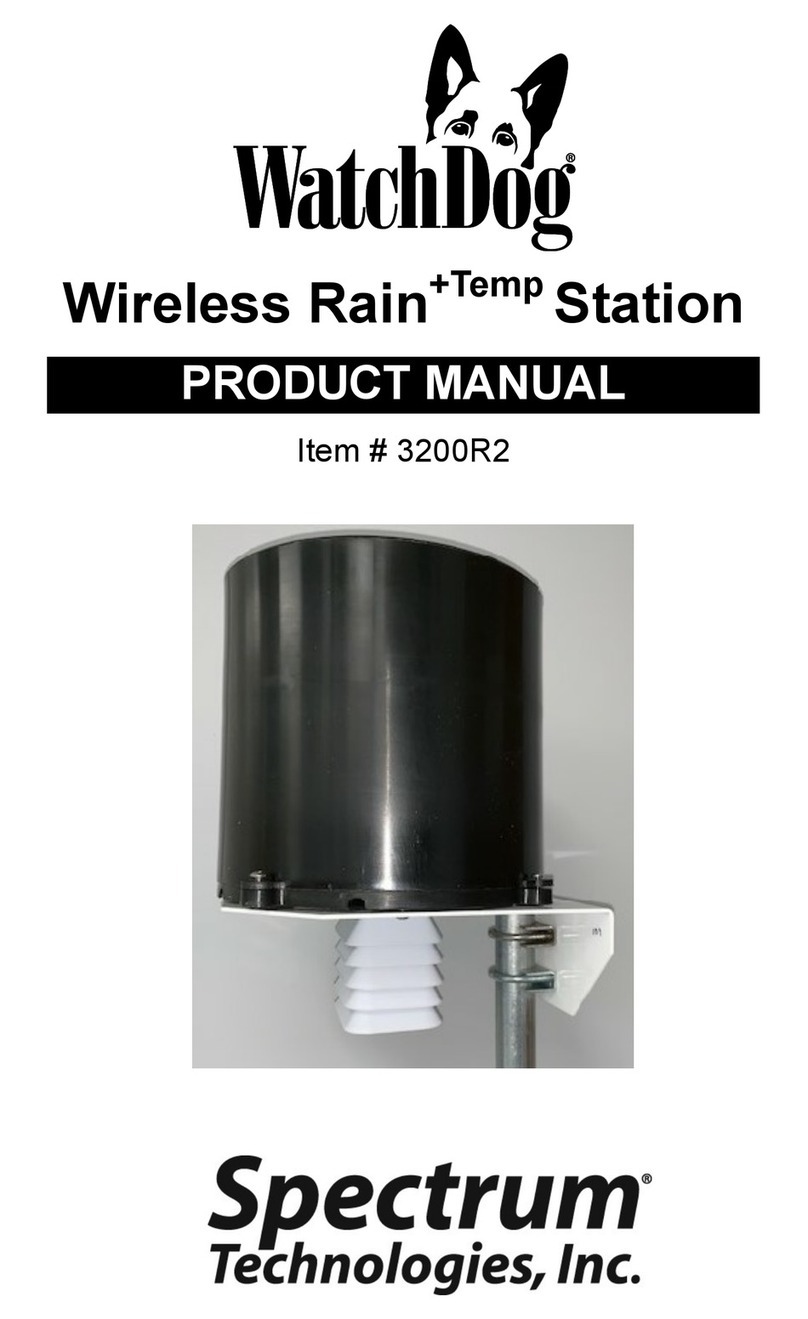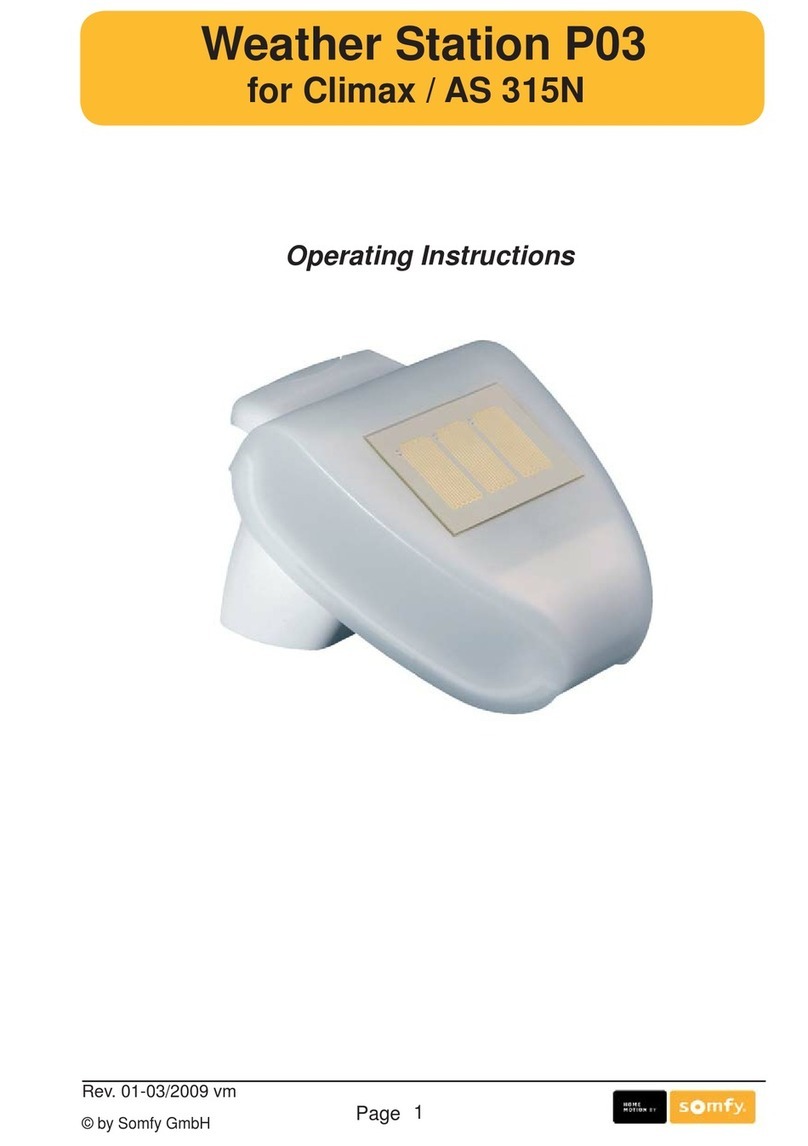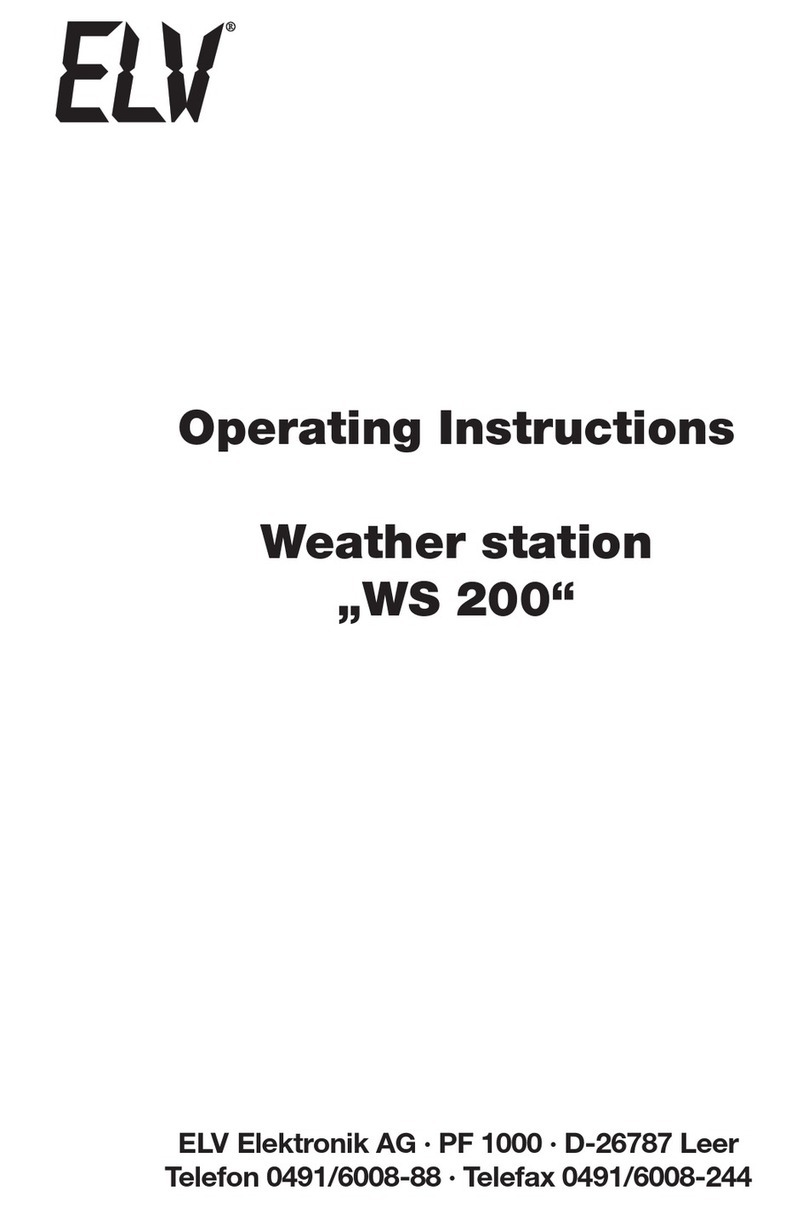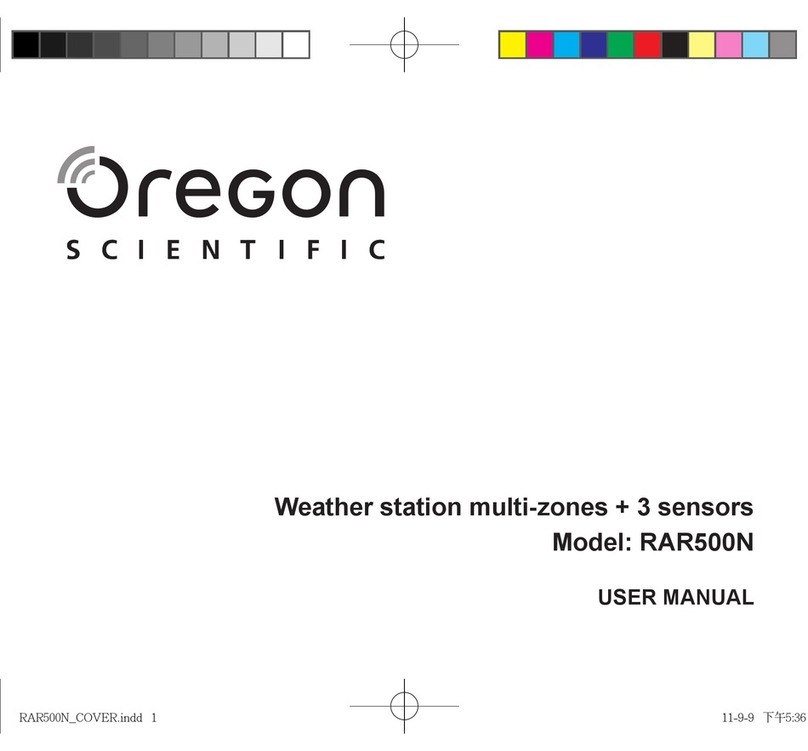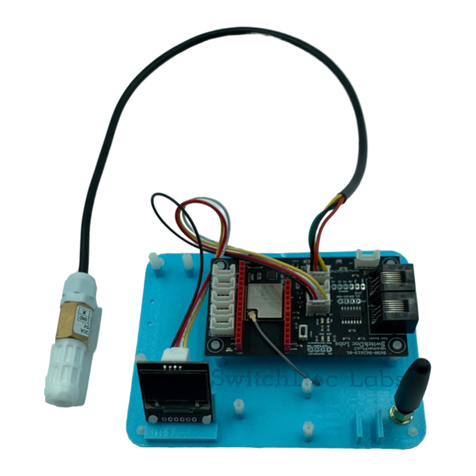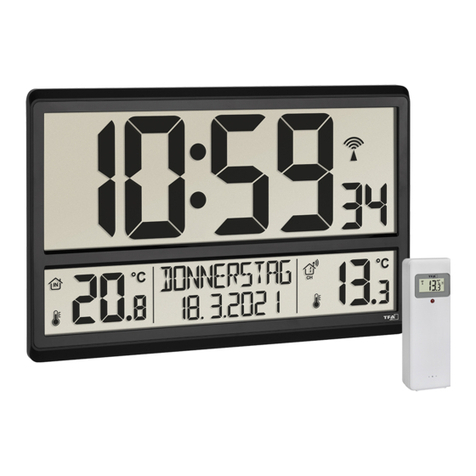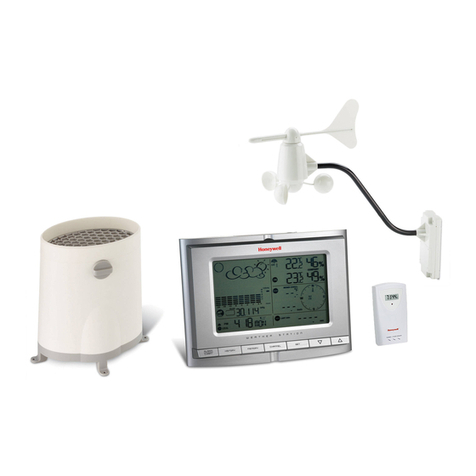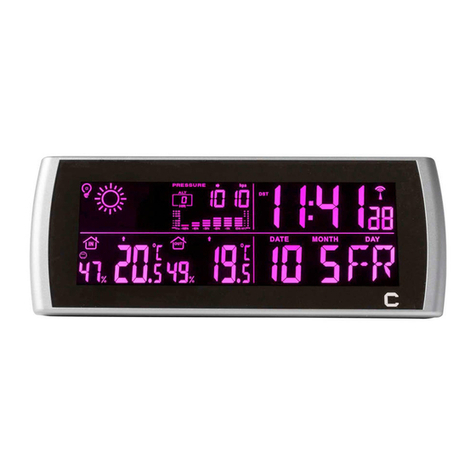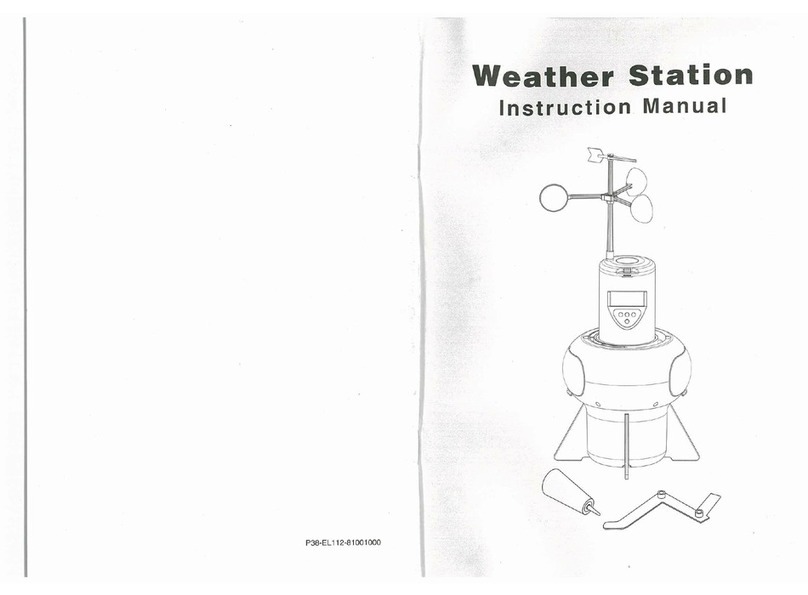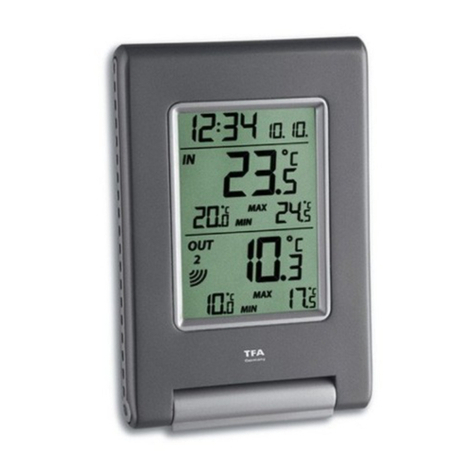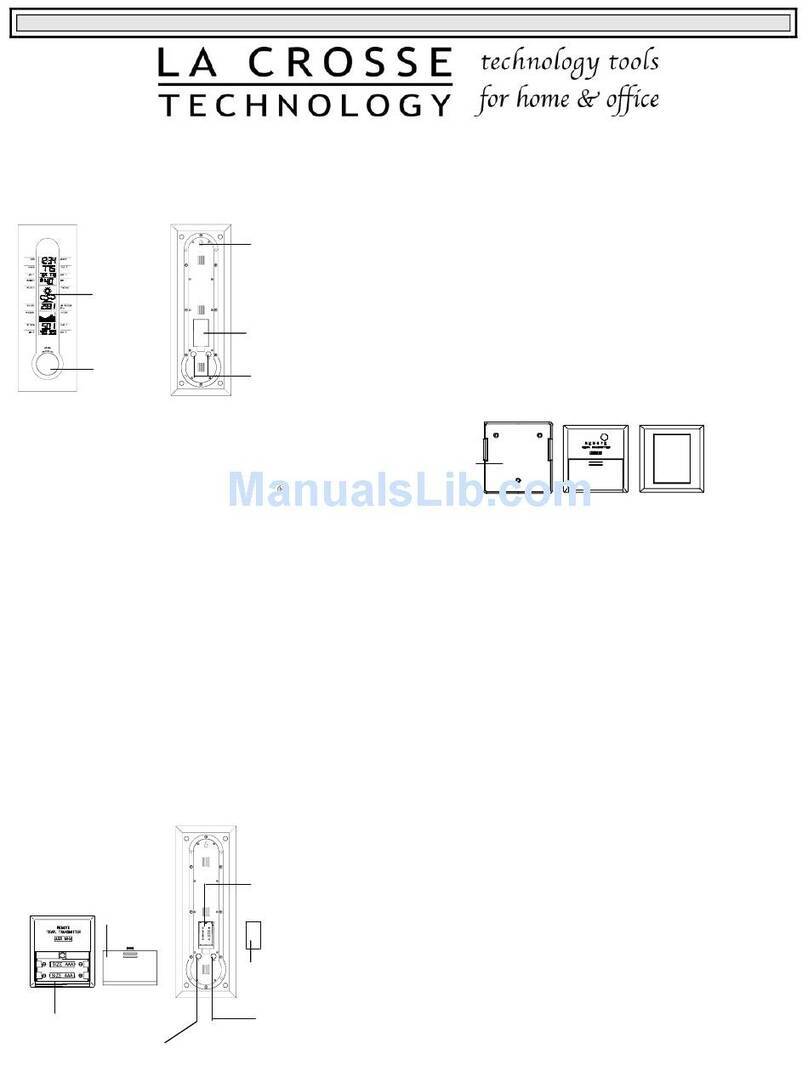Spectrum WatchDog 2900ET User manual

1
2000 Series
Weather Stations
PRODUCT MANUAL
Model #’s
2900ET, 2800, 2700, 2550

2
QUICK START
1. Check the Box
Verify all components are included
Pg 5
2. Set up Anemometer & Install the
Station
Pg 8 - 9
3. Configuring the Weather Station
Setting the logging interval, sensor type,
geographic data, and degree day calcu-
lation
Pg 13 - 17
4. Keypad Operations
Setting date, time, display units, degree
day counter, chill hour counter.
Pg 18 - 22
5. Daily Archive
Accessing the daily data
Pg 25
6. Battery Replacement Pg 26
7. Clearing the Logger’s Memory Pg 27
8. LCD Display Descriptions Pg 28, 29

3
LCD Screens 28
Degree Days/Chill Hours 30
Rain Collector Adjustment 31
Warranty 32
CE Declaration of Conformity 32
CONTENTS
General Overview, Package Contents 4
Specifications 6
Anemometer Setup 8
Station Installation 9
Connection Options 10
Configuring the Weather Station 12
Configuring the Weather Station with SpecWare 13
Configuring the Weather Station with the Keypad 14
Setting the Logging Interval 14
Setting the Sensor Type 15
Setting Geographic Data for the ET Report 16
Setting the Degree Day Calculation Method 17
Other Keypad Operations 18
Setting the Date and Time 19
Setting the Display Units 20
Setting the Degree Day Counter 21
Setting the Chill Hour Counter 22
Configuring the Wireless Radio Address 23
Calibrating the Wind Vane 23
Resetting the Rain Counter 24
Resetting the Disease Models 24
Daily Archive 25
Battery Replacement 26
Clearing the Loggers Memory 27

4
Thank you for purchasing a WatchDog 2000 Series
Weather Station. The stations are completely weath-
erproof and feature 12-bit resolution for higher accu-
racy. The stations can be accessed at different times
by multiple users because the data is not cleared
from memory following a download. The 2000-Series
weather stations can communicate via direct-wire,
radio or telephone connections.
Current weather conditions, historical data, and com-
puted parameters are easily viewed on the station’s
LCD screen. The station LCD can also be pro-
grammed to display a variety of plant disease infec-
tion potentials. The arrow keys can be used to pro-
gram the station’s logging interval and assign sen-
sors to the external sensor ports. You can also
scroll through the sensor readings, Degree Day/Chill
Hour calculations and set your temperature ranges.
General overview
Model 2800 Stations
The model 2800 station is equipped with 9 external
sensor ports. It can be connected to any WatchDog
external sensor. This station is unique in that it has
no internal sensors. It is not possible to collect data
for air temperature, relative humidity, and wind
speed/direction. Therefore, the station cannot calcu-
late Growing Degree Days, Chill Hours, Wind Chill,
Dewpoint, Evapotranspiration or any Disease Mod-
els.
Although a rain collector is not included as a stand-
ard sensor, it can be added as an optional external
sensor.

5
Package Contents
Your 2000 Series Weather Station package should con-
tain the following components:
Manual
Weather Station
Parts Box
Wind Vane
Wind Cups
4 AA Batteries
Ground Screw
Allen Wrench
Mounting Hardware - used to attach station to
Pole
Other tools needed, but not included:
Phillips screwdriver
Ground screw bottom clamp
Specifications
Data capacity
8800 data intervals. For example, for a 30-min interval, the sta-
tion will run for 183 days before wrapping data.
Size
2900ET, 2700:
12 in (30 cm) x 8.5 in (21.5 cm) x 12 in (30 cm)
2550, 2800:
10 in (26 cm) x 8.5 in (21.5 cm) x 3.5 in (8.5 cm)
Weight (with rain collector and anemometer)
6.4 lbs (2.9 kg)
Power Source
4 AA batteries
Battery Life
10 months with alkaline batteries, 12 months with Lithium
Available External Sensor ports
6 (5 on model 2900ET, 9 on model 2800)
Included Sensors
The following table lists the specifications for sensors that are
included with the different models of weather station.

6
Specifications (cont.)
Sensor Measurement AccuracyAvailable on
Wind Speed 0, 2-150 mph
0, 3-241 km/h
±2 mph (±3
km/h), ±5%
All but 2800
Wind Direction 1o increments ±4oAll but 2800
Air
Temperature*
-40° to 125°C
-40° to 257°F
±0.3°C
±0.5°F
All but 2800
Relative
Humidity*
0% to 100%
@5° to 50°C
±2%
2550, 2700,
2900ET
Dew Point 2550, 2700,
2900ET
-73° to 60°C
-99° to 140°F
±2°C
±4°F
Rainfall 0.01” (0.25mm)
resolution
±2% at < 2 in
(5 cm) /hr
2600, 2700,
2900ET
Solar
Radiation 1-1500 W/m2±5%2900ET
Operating Temperature Range: -22° to 130°F (-30° to 55°C)
Weather
Station
Firmware
Version
Number of
Sensors
Available
Channels
2550, 2700 6.9 2A, D
2800 3.2 2A, D
2900ET 6.9 1A
For a Weather Station to be compatible with the SMEC300 sensor,
SpecWare software version 9.04 or later is required. See the following
table for the earliest compatible firmware and number of sensors that
can be used per station type.
* In 2016, Spectrum introduced a new T/RH sensor (3613WD). The
cable for this sensor emerges from the bottom of the radiation shield
rather than the side. A station must be running firmware v. 7.8 or high-
er to be compatible with this sensor.

7
External Sensors
The following table lists the available optional sensors. All
sensors include a 6-foot cable with pin-type connector. To
connect an external sensor to the logger, plug the sensor cable
into the logger port that has been programmed for that particular
sensor. If the sensor is not connected, the message “sensor
error” will appear on the LCD display for the respective logger
port until the sensor is connected.
Item # Sensor Description
3666 Leaf Wetness
3667 (6ft), 3667-20 (20ft) External (Soil) Temperature
3670i Silicon Pyranometer
3668i 3668i3, 3668i6 Quantum Light
3669 Soil Moisture Transducer
6470-6 (6ft), 6470-20 (20ft) WaterScout SMEC 300 Soil Moisture/EC/
Temp Sensor
6460 (6ft), 6460-20 (20ft) WaterScout SM 100 Soil Moisture Sensor
6450WD (6ft), 6450WD20 (20ft) Watermark Soil Moisture Sensor
6451 Irrigation On/Off
3671 Barometric Pressure
3673, 3674 Input Cable for User Supplied Sensor
3664 20 ft. Sensor Extension Cable

8
Anemometer setup
Apart from the anemometer,
the WatchDog Weather
Station comes fully assembled
and ready to mount. The
anemometer arm is attached
to the enclosure back plate
with two clamps. After
positioning the arm, the
screws should be tightened to
secure it in place.
A plastic envelope containing
a screw and a star washer are
included with the station. The
star washer should be used
under the screw holding the
bottom anemometer clamp.
Once the arm is positioned,
the self-tapping screw should
be screwed into the arm
through the hole drilled in the clamp. These parts improve
resistance to electrostatic discharge.
Push the wind cups onto the bottom of the
shaft flush with the bottom of the assembly
and tighten the set screw. When released,
the cups should drop slightly. If the cups do
not spin freely, loosen the set screw and
lower the cups slightly. The gap between cup
hub and assembly should be about 1/16 inch.
Push the wind vane onto the top of the shaft
and calibrate (see Calibrating the
Anemometer p. 23 for calibration procedure).
Anemometer clamped
to back plate
(unpainted clamps sub-
stituted for visibility)

9
The weather station should be located in an open, unobstructed,
grassy area to ensure accurate measurement of wind, rainfall,
sunlight, and evapotranspiration.
Mounting hardware is provided to attach the weather station to a
4” x 4” treated wooden post or to a mast/pole up to 1.25 inches in
diameter. The mounting pole should be securely anchored
perpendicular to the ground.
If you are using the mounting
tripod (item # 3396TP), open it
and place it where the weather
station is to be located. The tripod
feet can also serve as mounting
brackets if the unit is located on a
solid surface. Slide the 3’ post
through both center screw clamps,
adjust the height as desired and
tighten the screws such that the
post is perpendicular to the
ground. Finally, attach the
weather station to the post with
the u-bolts.
Weather Station mounted
on tripod
Station Installation
Important: Secure the external sensor wires to the
mounting pole with a plastic tie. This will ensure that the
sensor wires do not become disconnected while
recording.

10
Connection Options
The WatchDog weather station communicates with a PC
through either the Computer or AUX port which are lo-
cated under the LCD and keypad. The communication
options are separated into 3 main categories.
Direct Communication
There are 3 options for connecting directly to the station.
1. PC interface cable - The cable that accompanies the
SpecWare software. Connects to the Computer port.
2. A 75-ft Direct Connect Cable (item 3660-75SP) - This
cable has a modular (telephone-type) connector on
one end and a 9-pin RS-232 connector on the other.
Comes with surge protection and connected to the
station through the AUX port.
3. Short-Range Modem Pair - The weather station can
be hardwired up to 4000 feet from a PC with a twisted
-pair cable and a short-range modem pair. Powered
with an A/C adapter and connected to the station
through the AUX port.
Caution: Extended lengths of cable can attract lightning.
It is recommended that these cables always be connect-
ed to surge protectors. This provides upgraded protection
against voltage surges caused by nearby lightning strikes.
Wireless Radio Communication
There are 2 options for contacting the station by a wire-
less radio connection. The short-range transceiver can
communicate up to 1000 ft. The mid-range radio has a
range of 2 miles. Both wireless options require line of
sight between the base and remote radios. See the
WatchDog Wireless Modem user’s guide for additional
details.

11
Long-range (telephone) Communication
If the weather station will be located further than 2 miles
from the base PC and/or it is not possible to achieve line-
of-sight with the station, the only other remote connection
option is via a land-line or cellular telephone connection.
These modems are not waterproof and require a power
source other than the station’s AA batteries. If electricity
from a local utility is not available, this power will need to
come from a battery. It is common for this battery to be
charged by solar panels so that station does not need to
be visited on a frequent basis. Contact Spectrum Tech-
nologies for additional details on these options.
DataScout Modem (Cellular or WiFi)
The DataScout modem sends data to the SpecConnect
Web Utility. No pre-deployment configuration is neces-
sary for the WatchDog Weather Stations. Note that the
Weather Station firmware version must be 7.6 or higher
(3.5 or higher for model 2800) for use with the DataScout.
Caution: Be sure to remove the batteries from the station
before connecting the DataScout modem. Failure to do so
will lead to weather station damage.

12
The 2000-Series weather station does not have a
button or switch for powering up and down. Instead,
the device is operational whenever the batteries are
installed. The stations are shipped with default log-
ging settings that can be modified with SpecWare
software or with the station’s keypad. Once the sta-
tion is configured, it will retain those settings even
after the battery is removed or replaced.
Stations sold after January 2012 include a built in
clock with an independent battery. These stations
are set to USA Central time, and need to be reset for
other locations. The clock will continue to keep time
when the AA batteries are removed.
One notable feature of the WatchDog 2000-Series
weather stations is that they do not need to be re-
launched after being downloaded. This allows great-
er flexibility for stations that are accessed by multiple
users. Although, the station stores data on a pre-set
interval, the sensor readings displayed on the LCD
are refreshed every 20 seconds.
Configuring the
Weather Station

13
The 2000-Series weather stations can be configured in the
WatchDog Manager screen of SpecWare software (see
SpecWare9 User’s Guide for details). Click new station.
Configuration through the software is necessary to change
the station name, enable/disable Disease Models or set
parameters for the Alarm Output Module. Remember to
identify the WatchDog type as 2000-series.
Configuring the
Weather Station
with SpecWare

14
Configuring the
Weather Station
with the Keypad
For the 2000 Series weather stations, SpecWare software
is not necessary to configure the station. The keypad can
be used to select all essential configuration options. Con-
figurable parameters are; sensor type, logging interval,
Degree Day calculation method and latitude and altitude
(model 2900ET only). Configuration through the software
is necessary to change the station name, enable/disable
Disease Models or set parameters for the Alarm Output
Module.
The keypad sequences to set each parameter are as fol-
lows.
Setting the Logging Interval
If set for a 30-minute logging interval, the station can hold
183 days of data. Changing the logging interval will also
change the frequency that the station’s memory wraps
around and writes over older data.
5. Use the arrow keys to scroll to the desired port.
6. Press Set. LCD will return to the ‘Current Values’
screen.
1. Press Display.
2. Press Set.
Select Parameter
To Be Set (↑↓)
4. Press Set.Set Log Interval
Interval=30 min
3. Use the arrow keys to
scroll to the ‘Log Interval’
option.
SET LOG INTERVAL
Press SET

15
6. Press Set to select the port.
7. Use the arrow keys to
Set Port B Sensor
Select Type (↑↓)
sor type. LCD will then return to the ‘Current Val-
ues’ screen.
scroll to the desired sensor
type.
8. Press Set to select the sen-
Set Port B Sensor
PAR Light
1. Press Display.
2. Press Set.
Select Parameter
To Be Set (↑↓)
4. Press Set.Select Port Now
Select Port (↑↓)
3. Use the arrow keys to
scroll to the ‘Sensor Type’
option.
SET SENSOR TYPE
Press SET
5. Use the arrow keys to
scroll to the desired port.
Select Port Now
Port B Press Set
Setting the Sensor Type
Although the keypad can be used to assign a sensor to
an external port, this should only be done when initially
starting the station, re-starting a station whose memory
has been cleared, or for adding a sensor to a previously
unused port. If a port’s sensor assignation is changed
without first downloading the station, all data read from
that port, including historical data read before the change,
will be translated to engineering units as if the new sensor
had always been connected.

16
Setting Geographic Data for the ET Report
In addition to temperature, relative humidity, wind speed
and solar radiation data, the Penman-Monteith algorithm
used by the 2900ET statopm uses the station latitude and
altitude to compute reference ET. These are input as fol-
lows:
1. Press Display.
2. Press Set.
Select Parameter
To Be Set (↑↓)
4. Press Set.Set LATITUDE Now
Select LAT (↑↓)
3. Use the arrow keys to
scroll to the ‘ET Values’
option.
SET ET VALUES
Press SET
5. Use the arrow keys to
scroll to the desired
latitude. Take care
that N precedes the
latitude angle if the
station is in the north-
ern hemisphere.
Set LATITUDE Now
LAT=N45o Hit Set
6. Press Set to set the latitude
angle.
Set ALTITUDE Now
Select ALT (↑↓)
8. Press Set to set the altitude. LCD will return to the
‘Current Values’ screen.
7. Use the arrow keys to scroll
to the desired altitude.
Set ALTITUDE Now
ALT=500Feet

17
Selecting the Degree Day Calculation Method
The weather station has 2 options for calculating Degree
Days (see Degree Days/Chill Hours, p. 31). The weather
station must measure air temperature for this option to be
available. The desired method is selected as follows:
1. Press Display.
2. Press Set.
Select Parameter
To Be Set (↑↓)
3. Use the arrow keys to
scroll to the ‘DD Calc
Method’ option.
SET DD CALC METHOD
Press SET
7. Press Set to select the method. LCD will return to the
‘Current Values’ screen.
4. The current calculation
will be displayed.
DD TYPE = ACTUAL
Press SET
5. Press Set to make this
option modifiable.
DD TYPE = ******
6. Use the arrow keys to
select the desired
method.
DD TYPE = S SINE

18
Other Keypad
Operations
The most common use of the keypad is to view the
weather station’s current sensor readings, calculated pa-
rameters, and archived data. Pressing the Display key
once brings the LCD display to life. The screen will initial-
ly display descriptive information about the station. The
screen then displays current conditions. Current condi-
tions are refreshed every 20 seconds. Pressing the Dis-
play key a second time will deactivate the display. The
station continues to record data when the display is not
active. To conserve battery power, the display goes off
after 2 minutes of inactivity. The weather station only rec-
ords the measurements from the sensors. Parameters
calculated and displayed on the LCD by the firmware
(such as Growing Degree Days) are only retained in the
Daily Archive (see Daily Archive, p. 25).
In addition to being able to configure parameters needed
by SpecWare, the keypad is also used to set the date/
time, calibrate the wind vane, reset the running rain coun-
ter, configure the radio and select options for parameters
calculated and displayed by the station’s firmware.
The keypad sequences to set each parameter are de-
scribed on the following pages.

19
1. Press Display.
2. Press Set.
Select Parameter
To Be Set (↑↓)
4. Press Set.09-22-12 11:45AM
Press SET
**-22-12 11:45AM
5. Press Set.
3. Press the down arrow key
once to reach the ‘Time &
Date’ screen.
TIME & DATE
Press SET
6. Enter the month using the arrow keys. Press Set.
7. Enter the day. Press Set.
8. Enter the year. Press Set.
9. Enter the hour. Press Set.
10. Enter the minutes. Press Set.
11. Enter AM or PM. Press Set.
12. LCD will return to the ‘Current Values’ screen.
Setting the Date and Time
It is necessary to use the keypad to set the date and time
for the data being stored in the long-term memory. This is
the only keypad function that is reflected in the logged
data that can’t be handled via a software connection.
Stations sold after January 2012 include a built in clock
with an independent battery. The clock will continue to
keep time when the AA batteries are removed.

20
Setting the Display Units
This option determines whether the LCD will show data in
English or metric units.
6. Use the arrow keys to choose whether data is dis-
played in English or metric units.
7. Press Set. LCD will return to the ‘Current Values’
screen.
Note: The unit system used by the 2000-Series Weather
Station can be modified by both the keypad and by
SpecWare. Although it is advisable to have both the soft-
ware and firmware using the same unit system, it is not
required. SpecWare is equipped to handle situations
where it receives data in a different unit system. However,
if you use SpecWare to change any of the weather sta-
tion’s configuration parameters (i.e. logging interval), the
data logger will also be reconfigured to use the unit sys-
tem used by SpecWare.
3. Use arrows to scroll to
‘Display Units’.
DISPLAY UNITS
Press SET
1. Press Display.
2. Press Set.
Select Parameter
To Be Set (↑↓)
4. Press Set.UNITS = English
Press Set
5. Press Set.UNITS = *******
Press Set
This manual suits for next models
3
Table of contents
Other Spectrum Weather Station manuals
Popular Weather Station manuals by other brands

Conrad
Conrad DV206NL operating instructions

La Crosse Technology
La Crosse Technology ED31411 Quick setup guide
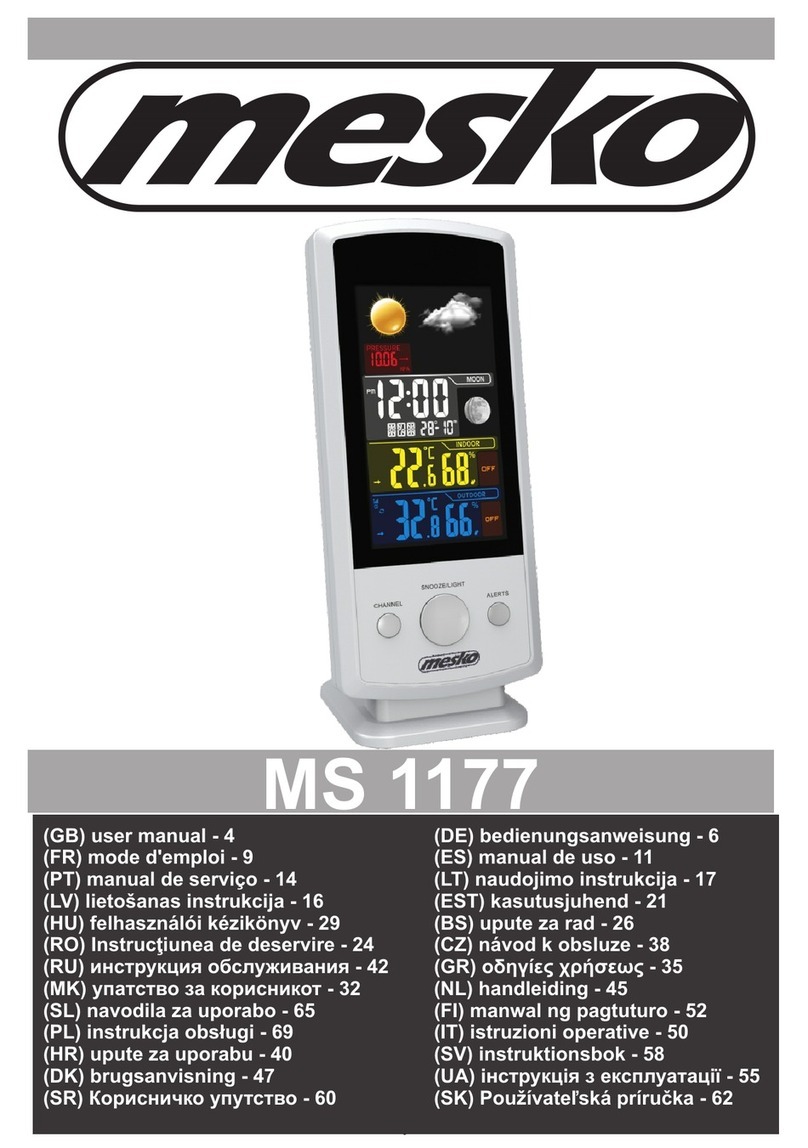
Mesko
Mesko MS 1177 user manual
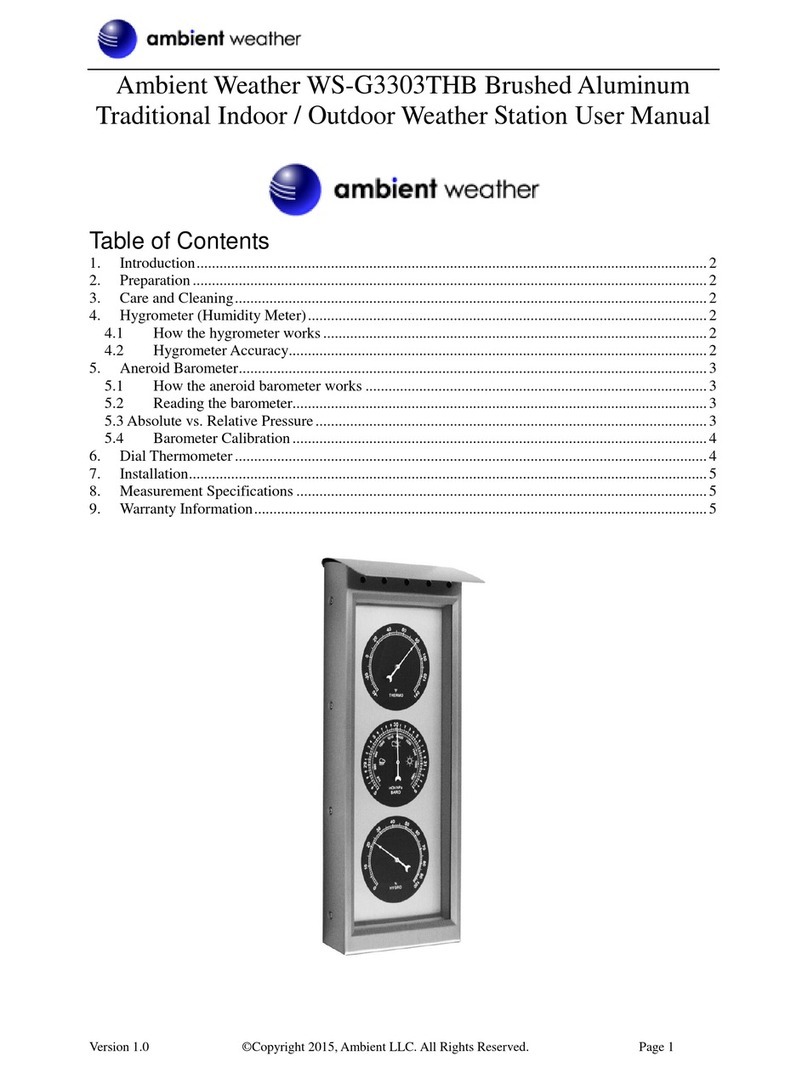
Ambient Weather
Ambient Weather WS-G3303THB user manual
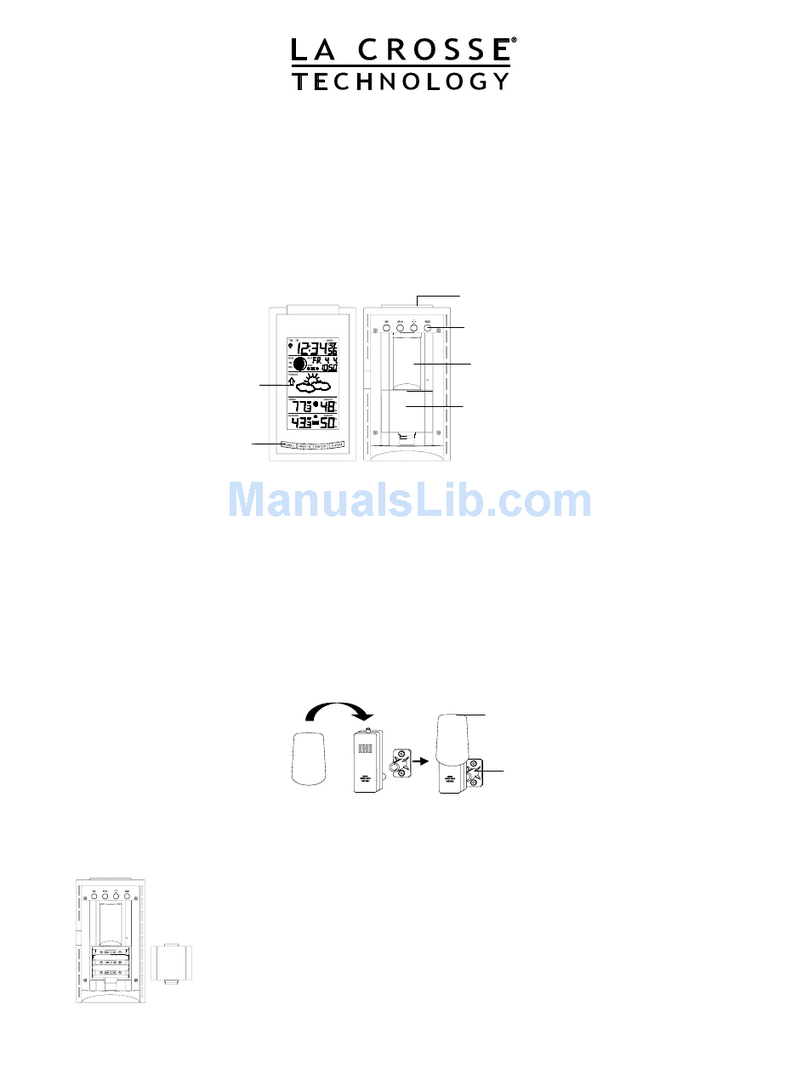
La Crosse Technology
La Crosse Technology WS-9025U instruction manual

Hyundai
Hyundai WS 1860 instruction manual
